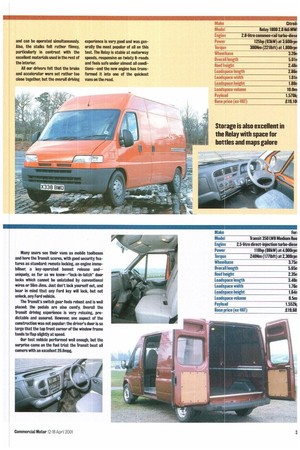T he Citroen is outselling its Sere! siblings so far this
Page 32

Page 33

If you've noticed an error in this article please click here to report it so we can fix it.
year and also holds the record for the best fuel consumption return around DM's Kent route...a formidable competitor.
Along with most other manufacturers Citroen has embraced common-rail fuel injection; the Relay's system comes with the latest 2.8litre engine from the Fiat/Iveco-built Sofim range. Other recent developments include an engine immobiliser, a heavier-duty dashboard and a new instrument panel with blue-tinted illumination. The gear lever is now mounted on the dashboard, as with the smaller Sevel models.
The 3.5-tonne Relay 1800 is only available with a high roof and can be specified in medium or long wheelbase, giving overall capacities of 10m3 and 12m3 respectively with payloads of 1,630kg and 1,540kg.
Buy a medium (3.2m) wheelbase 1800 and you'll get 10m3 of volume with a loadbay measuring 2.9m long, 1.9m high and 1.8m wide with 1,800kg of payload. The loadspace is a useful
square shape, and access is excellent: front-wheel drive keeps the load floor low, while both the side and rear load doers are full-height.
You can choose from three engines rated at 86hp for the basic 2.5-litre diesel, 110hp for the 2.5 TEli and 125hp for the 2.8-litre HIN common rail unit. More importantly, perhaps, the new engine produces a whopping 300Nm of torque at just 1,800rpm. Oddly, Citroen claims slightly higher power and torque figures than Iveco.
The Relay's seats are a little soft for our taste, but the driver's perch is adjustable for height and affords a comfortable position for all but the most oddly shaped occupants. However (as with several other vans on test) the full-width bulkhead restricts seat movement for the long-legged.
Three point seatbelts, used throughout, are height adjustable for driver and outer passenger. The centre passenger also gains a grab handle—a nice touch—while the passenger bench as a whole is good and wide, with the feeling of space improved further by the (initially confusing) right-hand-mounted hand brake. Visibility should be more than adequate through the deep screen, but taller drivers complained of the law windscreen line. The large rearview mirrors scored extremely highly with our panel, however. coming as they do with adjustable blind-spot sections on both sides.
Electric operation is not an option, but once set up these are certainly the best mirrors in the group and would prove the most useful on a dayto-day basis.
Storage is also excellent in the Relay with space for bottles and maps galore in a deep dear pocket on the driver's side with mesh trays under the passenger seat and by the driver and a lockable glove box.
The switch gear generally feels good, but the turn indicators and headlight stalk are easily confused and can be operated simultaneously. Also, the stalks felt rather flimsy, particularly in contrast with the excellent materials used in the rest of the interior.
All our drivers felt that the brake and accelerator were set rather too close together, but the overall driving experience is very good and was generally the most popular of all on this test. The Relay is stable at motorway speeds, responsive on twisty B-roads and feels safe under almost all conditions—and the new engine has transformed it into one of the quickest vans on the road.
































































































